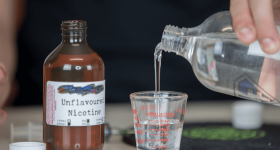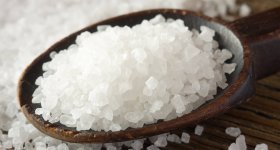1. General overview of the characteristics of potassium permanganate
Potassium permanganate , also known as potassium permanganate, has the chemical formula KMnO 4 .
Molecular structure of potassium permanganate potassium permanganate
Purple medicine has some outstanding properties as follows:
- It is a solid, odorless, dark purple crystal. However, if you don't store it carefully, it will turn a brownish purple color like copper.
- Infinitely soluble in water, forming a dark purple solution. If the solution is dilute, it will be purple-red.
Purple potion is infinitely soluble in water
- It is a strong oxidizing agent (i.e. capable of accepting electrons from other substances), able to oxidize both organic and inorganic matter.
- Ignites or explodes if combined with other organic matter.
Violet powder ignites when combined with some organic substances
- Decomposition temperature above 200 o C and 100g of water dissolved 6.4g KMnO 4 .
Currently, potassium permanganate is produced and applied in many areas of life and circulated on the market in the form of powder or crystals.
2. Application of potassium permanganate in practice
2.1. Remove some inorganic compounds in water
Have you ever encountered a water that smells bad or tastes strange? The main reason is that the water has been contaminated with iron (which makes the water smell fishy) and manganese. Potassium permanganate is used in water treatment to oxidize iron and manganese, to remove odor-causing compounds.
In the presence of oxygen, iron and manganese in the water will be oxidized causing the water to turn orange brown (iron oxide) or black (manganese oxide).
Image of water contaminated with iron (reddish brown) and manganese (black)
To oxidize 1mg Fe and 1mg Mn requires a corresponding amount of potassium permanganate 0.94mg and 1.92mg in a period of 5 - 10 minutes.
3Fe 2+ + KMnO 4 + 7H 2 O ⇒ 3Fe(OH) 3 + MnO 2 + K + + 5H +
3Mn 2+ + 2KMnO 4 + 2H 2 O ⇒ 5MnO 2 + 2K + + 4H +
2.2. Disinfectant, bactericidal
Pesticide has the ability to kill bacteria with a relatively low concentration, however, it requires the water source to contain less organic matter. Only 2 mg/l Potassium permanganate, 99% of gram-negative and positive bacteria can be killed. This effect is due to the permanganate ion MnO 4 - oxidizing bacterial cells.
Kills fungi and algae by directly oxidizing cell membranes, destroying enzymes that play an important role in cell metabolism.
Purple is used to kill algae in fish ponds
Remove dust caused in appliances and water pipes. The possibility of cholera and other water-related diseases can also be minimized by washing fruits, vegetables, and cookware with a diluted solution of potassium permanganate.
Note: The ratio should not be more than 0.5 mg/l water. If the purple dye is too concentrated, the vegetables will be easily crushed. After soaking, it is necessary to use clean water to wash again to remove the excess of potassium permanganate remaining on vegetables.
Use clean water to rinse after using diluted potassium permanganate solution
2.3. Detoxify water
- Potassium permanganate potassium permanganate reacts with many organic poisons. Once oxidized, the poison is no longer dangerous.
- For fishicide rotenone C 23 H 22 O 6 , 2 mg/l Potassium permanganate has the ability to remove 0.05 mg/l rotenone. However, in reality, ponds, lakes, and natural water sources need larger doses, about 2-2.5 mg for 0.05 mg of rotenone.
2.4. For medical use
- Used as disinfectant and fungicide.
- Treats various skin infections like eczema, dermatitis, acne and other fungal infections caused in hands and feet.
Potassium permanganate is used to treat many skin diseases
- People with purulent, oozing, and blistering wounds can also be treated with (diluted) potassium permanganate.
- The acute solution for treating fungal infections such as athlete's foot, where the affected foot is soaked in a solution of potassium permanganate in water for about 15 minutes.
- Diluted potassium permanganate solution is used to disinfect, disinfect, wash wounds, clean live....
2.5. Fish disease treatment
Many aquarium diseases are caused by external infections by parasites, bacteria and fungi. If not treated in time, the disease will spread and develop, causing mass death of fish.
Fish with gill fungus disease
- Cyanin is used to treat bacterial infections and skin ulcers. Besides, it also enhances water quality by minimizing biological oxidation demand and it also reacts with organic matter such as bacteria, algae and particles.
- Biologists recommend using potassium permanganate at a dose of 4-8 mg/l for ponds, with tanks it can be higher, but with a shorter exposure time.
2.6. Other Apps
- As a gas absorber, anti-infection in water.
- Used as an oxidizing agent of saccharin, vitamin C.
- Discolorant of starch, textiles,...
- In addition, it is also used in agriculture, aquaculture, metallurgical engineering and the environment.
Mixture of bleaching fabric from lemon and potassium permanganate
3. How to use potassium permanganate for water sources to ensure safety and effectiveness
3.1. In aquaculture
- Commercial potassium permanganate usually exists in the form of crystals or powder, so users need to completely dissolve it into the water before spreading it all over the pond. After the pond water contains potassium permanganate, the PO3 content in the water will be lowered, so it is necessary to fertilize (Note not to be used simultaneously with fishicide).
- Depending on the amount of organic compounds present in the water, the user balances the dose of potassium permanganate accordingly. Otherwise, the amount of drug will react with organic matter, becoming neutral and not enough virulence to destroy pathogens.
- When starting to use 2mg/l, the water will turn from purple to pink in about 8-12 hours, meaning the amount of potassium permanganate used is enough without needing to increase.
- If in 12 hours after treatment, the water color turns brown, that is not enough dose, so need to add 1-2mg/l of potassium permanganate.
- It is recommended to use potassium permanganate in the early morning so that the color change can be easily observed from 8 to 12 hours.
It is best to use potassium permanganate in the morning
- It is possible to use potassium permanganate to bathe fish for 30 minutes with a concentration of 10 mg/l. When using this method, it is necessary to pay special attention to the changes of fish to promptly handle abnormal signs and prevent unfortunate consequences that may occur. This is a method used a lot with earthen ponds.
- After bathing with potassium permanganate, fish should be soaked in a 0.02-1% saline solution for a few days or a week, depending on the type of fish. This method is very effective in the treatment of diseases caused by Columnaris.
3.2. In daily life
- Purple bleach is used to deodorize and taste water: maximum dose of 20mg/l
- At dosages of 2-4 mg/l, potassium permanganate has the ability to kill bacteria.
- From 50 mg/l, it has the ability to kill viruses.
4. Notes when using potassium permanganate
- It is necessary to accurately calculate the amount of water in the pond to avoid waste while still being virulent enough to kill pathogens.
- Store potassium permanganate in a cool, dark place, away from direct sunlight because potassium permanganate is a strong oxidizing agent.
- It is possible to kill algae in ponds by inhibiting the photochemical process. However, dead algae causes a lack of oxygen. Therefore, when using potassium permanganate, you need to turn on the fan continuously to stabilize the oxygen concentration in the water, avoiding the lack of air that causes shrimp, fish, ... to suffocate and die.
Increase turning on the water fan when using potassium permanganate in ponds
- Using potassium permanganate with some other antiseptics such as formaline, hydrogen peroxide...
- The processing process can affect seafood, so the interval between the two uses of potassium permanganate should be at least 4 days apart, note regularly monitoring the health of shrimp, fish,....

